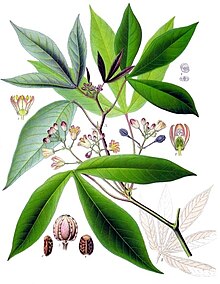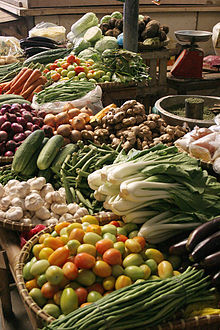C A S S A V A P I E
Cassava
Pie
Ingredients
½
lb Cassava
5
eggs
½
cup + 1 tablespoon sugar
¼
cup + 2 tablespoons butter
2
tablespoons flour
½
teaspoon nutmeg
½
teaspoon baking powder
1
teaspoon vanilla
1
lb chicken (boiled)
Method
1.
Preheat oven to 350°.
2.
Grease baking pan and set
aside.
3.
Boil chicken with water,
celery, salt, garlic salt, thyme and pepper.
4.
Ring or squeeze out
liquid out of Cassava with a cheese cloth or dish towel, pick through the
cassava and take out any skins that may be left in it.
5.
Cream butter and sugar.
6.
Add eggs, then add it to Cassava
mixture.
7.
Add vanilla.
8.
Add dry ingredients.
9.
Layer the bottom of the
pan, add chicken and another layer on top.
10.
Bake at 350°.

x
Cassava Pie was
made and prepared by Shirley-Ann Pearman
Photography
by Shirley-Ann Pearman
Recipe
derived from Betty Ming’s Farine
And Cassava Pie.
Other blog postings in reference to Christmas Pies as we call them in Bermuda.
Cassava Pie made and photos taken in December 2017.
Cassava
| Cassava | |
|---|---|
 | |
| Leaves of the cassava plant | |
 | |
| A manioc tuber | |
| Scientific classification | |
| Kingdom: | Plantae |
| Clade: | Angiosperms |
| Clade: | Eudicots |
| Clade: | Rosids |
| Order: | Malpighiales |
| Family: | Euphorbiaceae |
| Genus: | Manihot |
| Species: | M. esculenta |
Manihot esculenta, commonly called cassava (/kəˈsɑːvə/), manioc,[2] yuca, macaxeira, mandioca, aipim and Brazilian arrowroot,[citation needed] is a woody shrub native to South America of the spurge family, Euphorbiaceae. It is extensively cultivated as an annual crop in tropical and subtropical regions for its edible starchy tuberous root, a major source of carbohydrates. Though it is often called yuca in Spanish and in the United States, it differs from yucca, an unrelated fruit-bearing shrub in the family Asparagaceae. Cassava, when dried to a powdery (or pearly) extract, is called tapioca; its fried, granular form is named garri.
Cassava is the third-largest source of food carbohydrates in the tropics, after rice and maize.[3][4] Cassava is a major staple food in the developing world, providing a basic diet for over half a billion people.[5] It is one of the most drought-tolerant crops, capable of growing on marginal soils. Nigeria is the world's largest producer of cassava, while Thailand is the largest exporter of dried cassava.
Cassava is classified as either sweet or bitter. Like other roots and tubers, both bitter and sweet varieties of cassava contain antinutritional factors and toxins, with the bitter varieties containing much larger amounts.[6] It must be properly prepared before consumption, as improper preparation of cassava can leave enough residual cyanide to cause acute cyanide intoxication,[7][8] goiters, and even ataxia, partial paralysis, or death. The more toxic varieties of cassava are a fall-back resource (a "food security crop") in times of famine or food insecurity in some places.[7][6] Farmers often prefer the bitter varieties because they deter pests, animals, and thieves.[9]
Description[edit]
The cassava root is long and tapered, with a firm, homogeneous flesh encased in a detachable rind, about 1 mm thick, rough and brown on the outside. Commercial cultivars can be 5 to 10 cm (2.0 to 3.9 in) in diameter at the top, and around 15 to 30 cm (5.9 to 11.8 in) long. A woody vascular bundle runs along the root's axis. The flesh can be chalk-white or yellowish. Cassava roots are very rich in starch and contain small amounts of calcium (16 mg/100 g), phosphorus (27 mg/100 g), and vitamin C (20.6 mg/100 g).[10] However, they are poor in protein and other nutrients. In contrast, cassava leaves are a good source of protein (rich in lysine), but deficient in the amino acid methionine and possibly tryptophan.[11]
*************
PLEASE CLICK HERE

















